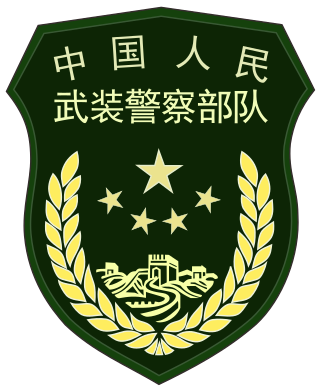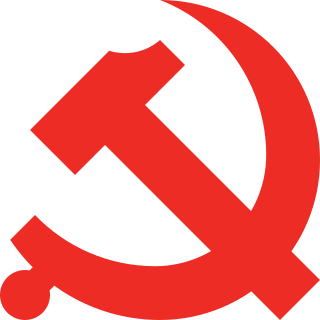
The People's Liberation Army Navy, also known as the People's Navy, PLA Navy or simply Chinese Navy, is the naval warfare branch of the People's Liberation Army, the standing armed force of the People's Republic of China. As of 2024, it is the second-largest navy in the world in terms of total displacement, and the largest navy per number of ships in active service.

The Republic of China Armed Forces are the armed forces of the Republic of China (ROC) that once ruled Mainland China and now currently restricted to its territorial jurisdictions of Taiwan, Penghu, Kinmen and Matsu Islands. They consist of the Army, Navy, Air Force and Military Police Force. The military is under the civilian control of the Ministry of National Defense, a cabinet-level agency overseen by the Legislative Yuan.

The People's Liberation Army (PLA) is the armed wing of the Chinese Communist Party (CCP) and the principal military force of the People's Republic of China. The PLA consists of four services — Ground Force, Navy, Air Force, and Rocket Force — and four arms — Aerospace Force, Cyberspace Force, Information Support Force, and Joint Logistics Support Force. It is led by the Central Military Commission (CMC) with its chairman as commander-in-chief.

The People's Armed Police Force is a Chinese paramilitary organization primarily responsible for internal security, riot control, counter-terrorism, disaster response, law enforcement and maritime rights protection as well as providing support to the People's Liberation Army (PLA) during wartime.

The Central Military Commission (CMC) is the highest national defense organization in the People's Republic of China, which heads the People's Liberation Army (PLA), the People's Armed Police (PAP), and the Militia of China.
In the People's Republic of China (PRC), supreme command of the armed forces is exercised by the Central Military Commission (CMC) of the Chinese Communist Party (CCP). A parallel state CMC exists. Legally the two CMCs have separate responsibilities, but the distinction is practically irrelevant because the bodies typically have the same members. Since the 2000s, the CCP General Secretary chairs the CMC, and represents the armed forces in the Politburo Standing Committee, the country's ruling body.

The People's Liberation Army Hong Kong Garrison is a garrison of the People's Liberation Army (PLA), responsible for defence duties in the Hong Kong Special Administrative Region (SAR) since the handover of Hong Kong in 1997.
The submarine hull No. 361 named Great Wall #61 (长城61号) was a Chinese People's Liberation Army Navy Type 035AIP conventional diesel/electric submarine. In April 2003, during a military exercise in the Yellow Sea between North Korea and China's Shandong Province, the vessel suffered a mechanical failure that killed all 70 crew members on board. It was one of China's worst peacetime military disasters. The PLA Navy's Commander Shi Yunsheng and Political Commissar Yang Huaiqing were both dismissed as a result of the accident.

A theater command (中国人民解放军战区) is a joint military command of the Central Military Commission that is composed of units from the service branches of the People's Liberation Army in its area of responsibility, and conducts broad and continuing missions. There are 5 theater commands: Eastern, Southern, Western, Northern, and Central theater commands, organized by a geographical basis. They are responsible for developing strategy, plans, tactics, and policy specific to their assigned area of responsibility. They are intended to take operational control of the multi-service units under their jurisdiction, while the branches retain administrative and "constructive" control.

The Battle of the Yijiangshan Islands occurred during the First Taiwan Strait Crisis in January 1955 when China (PRC) attacked and captured the islands from Taiwan (ROC). The loss of the Yijiangshans forced the ROC to abandon the Dachen Islands to the PRC. The Chinese People's Liberation Army (PLA) considers the battle as its first joint operation.
The national security of China is the coordination of a variety of organizations, including law enforcement, military, paramilitary, governmental, and intelligence agencies that aim to ensure China's national security. China considers three factors in its national security: national sovereignty, security, and development interests.

Wu Shengli is a retired Chinese admiral who served as commander of the People's Liberation Army Navy (PLAN) from 2006 to 2017. Prior to that, he served as PLA's deputy chief of staff, commander of the South Sea Fleet and commandant principal of Dalian Naval Academy.

The Pacific Fleet is the Russian Navy fleet in the Pacific Ocean. Established in 1731 as part of the Imperial Russian Navy, the fleet was known as the Okhotsk Military Flotilla (1731–1856) and Siberian Military Flotilla (1856–1918), formed to defend Russian interests in the Russian Far East region along the Pacific coast. In 1918 the fleet was inherited by the Russian Soviet Federative Socialist Republic, then the Soviet Union in 1922 as part of the Soviet Navy, being reformed several times before being disbanded in 1926. In 1932 it was re-established as the Pacific Fleet, and was known as the Red Banner Pacific Fleet after World War II as it had earned the Order of the Red Banner. In the Soviet years, the fleet was also responsible for the Soviet Navy's operations in the Indian Ocean and Arabian Sea. Following the collapse of the Soviet Union in 1991, the Red Banner Pacific Fleet was inherited by the Russian Federation as part of the Russian Navy and its current name was adopted.

Zhang Yongyi is a retired naval aviator and vice admiral of the Chinese People's Liberation Army Navy (PLAN). He served as a Deputy Commander of the PLAN from 2004 to 2013.

Zhang Dingfa was a submariner and admiral of China's People's Liberation Army Navy (PLAN), who served as Commander of the PLAN from 2003 to 2006. Prior to that, he served as President of the PLA Academy of Military Science and Commander of the North Sea Fleet.
The People's Republic of China military reform of 2015 was a major restructuring of the People's Liberation Army (PLA), which flattened the command structure and allowed the Chinese Communist Party (CCP) to have more control over the military, with the aim of strengthening the combat capability of the PLA.

The Eastern Theater Command is one of the five theater commands of the People's Liberation Army (PLA), founded 1 February 2016. It replaced the Nanjing Military Region. The command is headquartered in Nanjing.

Zhang Wendan is a retired vice admiral of the Chinese People's Liberation Army Navy. He served as Chief of Staff of the PLA Navy from January 2018 to December 2019, and previously served as Chief of Staff and Deputy Commander of the South Sea Fleet, Deputy Chief of Staff of the Southern Theater Command, and Commander of the North Sea Fleet (2017–2018). He commanded the PLA Navy's fifth Gulf of Aden anti-piracy task force in 2010.
Bai Yaoping is a major general (shaojiang) of the People's Liberation Army (PLA), serving as deputy commander of Northern Theater Command Navy since July 2021. He previously served as deputy commander of Eastern Theater Command Navy.

The Joint Operations Command Center of the Central Military Commission (JOCC). is the main command and control of the combined forces of the People's Liberation Army. It is a Theater Command Grade unit under the direct control of the Central Military Commission. Its main headquarter and operations command room is located in an underground location in the Haidian District of Beijing














